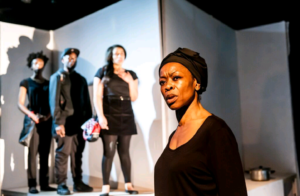
 (5 / 5)
(5 / 5)
The smash hit musical production returned to the Centre with director and choreograph Craig Revel Horwood from Strictly Come Dancing at the helm. Who gave this tried and tested production that has gone through various permutations since the 1992 Whoopi Goldberg film a real musical heart.
Sister Act tells the hilarious story of Deloris Van Cartier, a sassy nightclub singer in 1977/78 in need of witness protection after witnessing a murder. Deloris is hidden in the one place she won’t be found – a convent! Forced to wear a habit, and eat nothing but mutton, Deloris clashes with Mother Superior and begins to lead her fellow sisters astray, until she finds her calling in teaching them to sing.
Alexandra Burke really shines in the lead role of Deloris Van Cartier, each witty line or facial expression is delivered to perfection. However, it is when she opens her mouth to sing, we’re reminded of why audiences voted for her in there millions during 2008 X Factor. Burke’s voice never falters; her dancing is wonderfully expressive and comedic, it is her ability to make her audience laugh while ensuring their feet never stop tapping, makes her truly sensational as Deloris.
This show contains a fabulous group of musicians, who, instead of playing in the orchestra pit, take the role of various characters such as the trumpet playing Mother Superior played by Karen Mann. Who along with Burke are truly at the heart of this warm, funny and entertaining production but they are by no means the only ones. The whole cast displays a great deal of energy and enthusiasm and present as though they are loving life when signing Alan Menken original musical numbers including ‘Raise Your Voice,’ ‘Take Me to Heaven,’ and the show-stopping finale ‘Spread the Love Around.’
From the first moment to the big finale, the show is wonderful. A perfect lead in Burke, a great cast as well as a superb script and songs have been combined perfectly by the director into perhaps the best show to grace the stage of the Centre in a long time.
https://www.wmc.org.uk/Productions/2017-2018/DonaldGordonTheatre/SisterAct/
Category Archives: Theatre
BSL, Subtitled Video review, You’ve Got Dragons by Taking Flight Theatre Company performed at Chapter Arts Centre, Cardiff reviewed by Steph Back.
A BSL subtitled video review of You’ve Got Dragons by Taking Flight Theatre Company performed at Chapter Arts Centre, Cardiff reviewed by Steph Back.
Production information
“A delightful tale of one child’s journey to come to terms with their dragons, told in Taking Flight’s unique style. With toe-tapping music, this highly visual, sensitive production is a humorous and touching exploration of the ‘dragons’ we all face.
A fully accessible intergenerational show featuring creative captioning, BSL and audio description it is a treat for all the family … and remember ‘no dragon is more powerful than YOU’!”
Review Scarlett at Theatr Clwyd by Gareth Williams

 (3 / 5)
(3 / 5)
There is much to love in Scarlett. This one act play is short and sweet. Yet don’t think it lacks depth. It tackles issues of identity, family and death in a very humorous and conversational way. Part of its appeal lies in the relationships between the three generations of women onstage – protagonist Scarlett, her daughter Lydia, and her overbearing mother Bette. Scarlett is having some kind of midlife crisis. Or is it? Whatever her reasons, she has decided to travel from London to rural Wales in search of a new place to live. The small stage represents a patch of Welsh countryside, on which sit two rocks and a dilapidated stone building. This building appears to be the perfect place for Scarlett (played by Kate Ashfield) to start a new life for herself. This is in spite of local landowner Eria (Lynn Hunter) insisting it’s a chapel, and Lydia and Bette referring to it as nothing more than a shed.
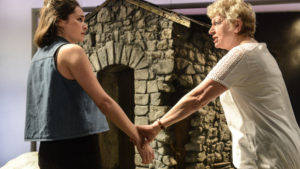
Writer Colette Kane uses these differences of opinion to create a very witty, sometimes poignant, script. The dialogue is often rapid. The characterisation is scarily familiar. I could see elements of my own family in all three generations of women, yet this only added to the humour. Joanna Bacon is superb as Scarlett’s demanding and self-righteous mother. There is a fierce outer shell yet an inner vulnerability to Lydia which Bethan Cullinane manages to balance effortlessly well. As for Scarlett herself, Ashfield has landed a strong and empowering role. She commands the stage, not imperiously, but simply by embodying the character so well. There is no doubt that this effervescent and strong-willed woman is the central figure in a play that is not afraid to speak plainly about sex, status and self-worth from a wholly-female perspective.
Kane’s script can be very subtle in its character arcs. I say this because the characters can feel fully formed when we first meet them, yet over the course of the play, there is a change in their outlook and perspective. This is not always obvious. Sometimes, the change is too subtle. When the lights came up and the cast took their bows, I admit that I was slightly surprised. I was expecting an interval, to stay with these characters beyond 75 minutes. It is testament to Kane that they became so familiar and likeable, yet I couldn’t help feeling that there was more of their story to tell. As a result, I left feeling slightly dissatisfied: not what I wanted to feel.
Scarlett is a play hardwired in reality. It deals with identity and relationships in a very unassuming, conversational way. I don’t think it’s a standout production, but it certainly feels relevant. It may be short and sweet, but it has a lot to say about life, love and loss.
https://www.theatrclwyd.com/en/whats-on/scarlett/
Review National Theatre Live: Twelfth Night by Danielle O’Shea
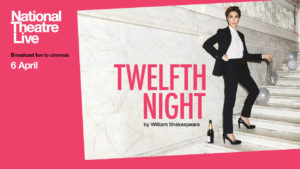
 (4 / 5)
(4 / 5)
Twelfth Night is Shakespeare’s classical comedy about love, gender and things not always being as they seem. This story became all the more poignant considering recent discussions of gender and sexuality.
In his pre-show interview, Director Simon Godwin described his interpretation as being a comedy wrought with pain and this was evident throughout. Despite the humour which trails through almost every scene, it is undeniable that each character has their own pain – whether this be due to grief or unrequited love – and Godwin made sure not to shy away from this pain but instead to embrace it. The emphasis on character was drawn even stronger by the minimalist settings which centred around a staircase that was manipulated from scene to scene from boat to church to club and so on.
https://youtu.be/O_93ev18DcY
Each member of the cast was incredible and their passion for their role was palpable however two stood out for me. Tamsin Greig as Malvolia presented a stunning portrayal of the stern turned vulnerable steward who every member of the audience empathised with whether it be from her assumed romantic triumph to downfall. In addition, Daniel Rigby forced the character of Sir Andrew Aguecheek into the spotlight with an absolutely hilarious performance that left everyone in tears.
Overall, it was a marvellous experience which was incredibly inclusive in its staging leaving little room for those unfamiliar to Shakespeare to go astray. In Godwin’s interpretation, the political and social connotations of the show were celebrated which encouraged conversation both onstage and off that had previously gone unmentioned. Altogether, it was a show that united both audience and cast in spellbinding switch-up of the classic.
National Theatre Live: Twelfth Night
Gwyn Hall, Neath
April 6th 2017
Running time: 3 hrs 10 mins
Author: William Shakespeare
Director: Simon Godwin
Design: Soutra Gilmour (Designer), James Farncombe (Lighting Designer), Shelley Maxwell (Movement Director), Michael Bruce (Music), Christopher Shutt (Sound Designer), Jeannette Nelson (Company Voice Work), Kev McCurdy (Fight Director), Alice Knight (Staff Director)
Cast: Tamara Lawrence, Daniel Ezra, Oliver Chris, Emmanuel Kojo, Brad Morrison, James Wallace, Tim Mc Mullan, Niky Wardley, Daniel Rigby, Adam Best, Doon Mackichan, Phoebe Fox, Tamsin Greig, Imogen Doel, Whitney Kehinde, Ammar Duffus, Claire Cordier, Mary Doherty, Andrew MacBean, Imogen Slaughter.
Review Caitlin, Light, Ladd & Emberton, Theatr Brycheiniog by Hannah Goslin
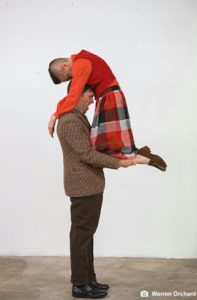
 (5 / 5)
(5 / 5)
As a huge fan of Eddie Ladd, Deborah Light and Gwyn Emberton, I have been excited to see Caitlin for a long time – missing the chance when it came to London, my visit to Brecon happily coincided with their Welsh tour.
Directed by Light and choreographed and performed by Emberton and Ladd, the story of the piece is based upon the poet Dylan Thomas’s wife, Caitlin, her turbulent life with the Swansea celebrity and her alcoholism beginning before and continuing after his death.
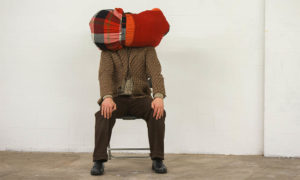
Set out in a circle of chairs, the story unfolds before us as an AA meeting but the words are simple sentences and the rest purely physical. The chairs soon became metaphors and symbolism for lovers, baby chairs and Thomas’s gradual success until his death where he (literally) falls from grace.
https://youtu.be/_21dOoSAqWc
I do feel slightly biased in the fact that these three dancers are such huge inspirations to me, but I couldn’t express how fluid and creative the movement were. Times where you could only imagine pain and impact of the body seemed so gentle and as if they did not hurt the performers was astounding. And they used every bit of space and every chair. It was a wonderful take on Caitlin’s life.
My only argument would be that I wanted more of the physicality and less of the chairs. While I completely understood the reasons behind the chairs, as a fan I just wanted more – perhaps that’s just me being greedy!
To accompany, the music was interesting, with no social/cultural significance but only to heighten the movement. And no particular theatrical lighting, giving the room a naturalistic feel rather than something created for theatrical purpose.
Caitlin, as all of Light, Ladd and Embertons work as a group and as individuals is a triumph. A beautiful representation of love, addiction and pain.
Directed by Deborah Light
Devised with and performed by Eddie Ladd and Gwyn Emberton
Sound by Siôn Orgon
Costumes by Neil Davies
Images by Warren Orchard
http://www.gwynembertondance.com/caitlin/
Caitlin – spring tour 2017
27-28 March // Aberystwyth
2 April // Laugharne
https://www.eventbrite.co.uk/e/caitlin-by-light-ladd-emberton-laugharne-shows-tickets-31967232854
5 April // Theatr Brycheiniog, Brecon
http://www.brycheiniog.co.uk
8 April // Theatr Ardudwy, Harlech
http://www.theatrardudwy.cymru/
11-15 April // Chapter, Caerdydd/ Cardiff
http://www.chapter.org/caitlin-0
21 April // Ffwrnes, Llanelli
http://www.theatrausirgar.co.uk/en/
23 April // Llandrindod Wells
http://dawnspowysdance.org/events/
25 April // Barry Memo
http://www.memoartscentre.co.uk/events/caitlin-2/
28-29 April // Galeri, Caernarfon
http://www.galericaernarfon.com
4 May // Taliesin, Swansea/ Abertawe
http://www.taliesinartscentre.co.uk/
BSL, Subtitled Video Review, Killology, Sherman Theatre by Steph Back
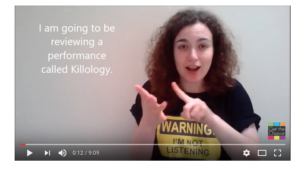
A BSL subtitled video review of Killology. Written by Gary Owen and directed by Rachel O’Riordan performed at Sherman Theatre, Cardiff reviewed by Steph Back.
The production can be seen at The Royal Court ,Thu 25 May – Sat 24 June.
CREATIVE TEAM
By Gary Owen
Director Rachel O’Riordan
Designer Gary McCann
Lighting Designer Kevin Treacy
Composer and Sound Designer Simon Slater
Sound Sam Jones
CAST
Sean Gleeson
SEÁN GLEESON
For the Royal Court: The Weir.
Other theatre includes: The Curious Incident of the Dog in the Night-Time (National/West End); Earthquakes in London (Headlong/National); The Contractor (Oxford Stage Company); In Celebration (Everyman, Chichester); Molly Sweeney (Bristol Old Vic); Aristocrats (Chichester Festival).
Television includes: Midsomer Murders, The Café, Public Enemies, Casualty, Doctors, Dalziel & Pascoe, Burnside, Holby City, Safe House, EastEnders, Underworld.
Film includes: The Last Witness, Cold Mountain, First Knight.
Sean also directs for TV and Film
Richard Mylan
RICHARD MYLAN
Theatre includes: The Believers, Things I Know to be True, Peep Show (Frantic Assembly); Starlight Express (West End); How I Helped Out Communism (Lowry); Crazy Gary’s Mobile Disco (Paines Plough); Badfinger (Donmar).
Television includes: Marked, Byw Celwydd, Agatha Raisin, Waterloo Road, Casualty, Doctors, Grown Ups, My Family, Where the Heart Is, Belonging, No Angels, Coupling, Bad Girls, Wild West, Score, Doctors, A&E, The Bill, Border Café, Silent Witness.
Films include: Don’t Knock Twice, City Rats, Upside of Anger, Love Peace & Pancake, Checkout Girl, Snarl Up, Dead on Time, The Wisdom of Crocodiles.
Radio includes: Look Who’s Back, A Taste of Honey.
Sion Daniel Young
SION DANIEL YOUNG
For Sherman Theatre: Llwyth
Other theatre includes: The Curious Incident of the Dog in the Night-Time (National /West End), Mametz, The Radicalisation of Bradley Manning, House of America (National Theatre Wales); War Horse (National/West End); The Welsh Boy (Theatre Royal, Bath).
Television includes: Hinterland, Our World War, Casualty, Gwaith Cartref.
Film includes: Another Me, Private Peaceful, Daisy Chain.
Radio includes: Hoshiko, Inside Information, Dolls Tea Set, Inside Information, Bisgits a balaclafas.
GARY OWEN (SHERMAN ASSOCIATE ARTIST: WRITER)
For Sherman Theatre: Iphigenia in Splott (& National/ UK Tour/ International Tour), Love Steals Us From Loneliness (& National Theatre Wales), Amgen/Broken, A Christmas Carol
For the Royal Court: Violence & Son.
Other theatre includes: We That Are Left, Mrs Reynolds & the Ruffian, Perfect Match (Watford Palace); Free Folk (Forest Forge); The Shadow of a Boy, Big Hopes (National); Crazy Gary’s Mobile Disco (& Paines Plough), Ghost City (Sgript Cymru); In the Pipeline (& Òran Mór), The Drowned World (Paines Plough); Cancer Time (503); Sk8 (Theatre Royal, Plymouth); Blackthorn (Clywd Theatr Cymru); Mary Twice (Bridgend Youth); Bulletproof (Replay, Belfast); La Ronde, Spring Awakening (Royal Welsh College of Music & Drama).
Television includes: Baker Boys (co-writer).
Awards include:
Meyer Whitworth Award, The Shadow of a Boy;
George Devine Award, The Shadow of a Boy;
Fringe First Award, The Drowned World;
Pearson Best Play Award, The Drowned World;
UK Theatre Award for Best New Play, Iphigenia in Splott;
James Tait Black Prize for Drama, Iphigenia in Splott;
Gary is Associate Artist: Writer at Sherman Theatre and is a Creative Associate at Watford Palace Theatre.
RACHEL O’RIORDAN (DIRECTOR)
Rachel is the Artistic Director of the Sherman Theatre.
For Sherman Theatre: The Weir (& Tobacco Factory Theatres), Bird (& Royal Exchange Theatre), The Lion The Witch & The Wardrobe, A Doll’s House, Iphigenia in Splott (transfer to The National / UK Tour / International tour), Romeo & Juliet, Arabian Nights.
Other Theatre includes: Macbeth (& Tron), The Seafarer (& Lyric, Belfast), The Odd Couple – Female Version, Moonlight & Magnolias, Someone Who’ll Watch Over Me, Twelfth Night (Perth); Unfaithful (Traverse); The Absence of Women (Tricycle); Hurricane (West End/Off-Broadway); Everything Is Illuminated (Hampstead); Miss Julie, Animal Farm (Peter Hall Company/Theatre Royal, Bath); Absolution (Guna Nua/First Irish Festival NY); Much Ado About Nothing, The Glass Menagerie, Merry Christmas Betty Ford (Lyric, Belfast); A Christmas Carol, Gates of Gold, Grimm Tales (Library, Manchester); Over the Bridge (Green Shoot/Waterfront Hall, Belfast); Protestants (Soho); Arguments for Terrorism, Cold Turkey at Nana’s (Òran Mór).
Opera includes: NI5 (Northern Ireland Opera/MAC, Belfast).
Awards include:
Critic’s Award for Theatre in Scotland for Best Director, The Seafarer;
First Irish Theatre Festival Award for Best Director, Absolution;
Rachel was formerly Artistic Director at Perth Theatre.
Review: Rent by Gemma Treharne-Foose
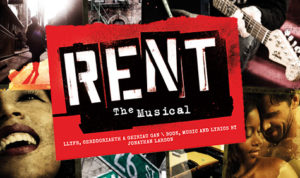
First things first, let’s get one thing clear – I am a steadfast ‘Rent Head’ and after this show – will remain so probably for the rest of my life and I make no apologies for this.
That being said, it’s been a whole 19 years since I was wowed (age 17 – yikes) by Jonathan Larson’s rock opera for a modern age. I wasn’t sure if the years had been kind to this production – would I even like it anymore? The show’s UK tour marks the 20th anniversary of the show.
Rent may have been billed as a parable of the modern age (inspired by Puccini’s opera La bohème), but it was also a snapshot of the 90s era, too: the cusp of the digital revolution, the internet age, the crude expansion of gentrification or ‘hipsterfication’ of previously bohemian neighbourhoods, the effects of AIDS on young communities following the 80s epidemic and scare stories. Maybe it would have lost some of it’s relevance? I had my reservations.
Back in 1998 at Shaftesbury Theatre in London, Rent was still very much in it’s infancy and was at the peak of it’s popularity, having won a shower of critical acclaim stateside (Pulitzer drama prize,four Tony awards, six Drama desk Awards, ‘Best Musical’ Awards and an Obie Award).

In ‘98, this was a show unlike anything else I had seen before. When I last saw it. I was an idiot teenager with a questionable taste in ridiculous infantile men. By the time I emerged from that theatre though, it shifted my view of the world.
But suddenly, my childish attempts to write poetry suddenly had context and purpose. I too wanted to dance on the table wearing spandex and hang from poles singing at the top of my voice like Mimi Marquez, go on protests like Maureen and befriend drag queens just like Angel Schunard.
In fact I did all of things…even though I couldn’t legitimately call myself a bohemian due to my love for global coffee chains. But even so – it didn’t even matter that my poetry was shit! I loved the way Jonathan Larson had pushed boundaries in the theatre world. I even went on to study Theatre and Media Drama and found my own little theatre circle…and my battered Rent CD (original Broadway cast recording) has accompanied me on all my journeys around the world since my 17th birthday.
So how to go about fairly reviewing a show that I have such a strong personal attachment to?
It may have been 19 years since I last saw Rent, but I can certainly see the differences (and improvements).
Lee Proud’s choreography was electric (fans of La Vie Boheme will love the table and chair dance), Angel’s acrobatic dance routine and of course the memorable ‘Tango Maureen’ – better and edgier than I remember at the Shaftesbury Theatre. Anna Fleischle’s set design includes multiple scaffolding layers on all sides and there nice touches – projecting Mark’s film on an old sheet, a trapeze, a pole, moving structures as vehicles for the characters, cages during the song ‘Contact’ – Maureen’s hilarious costume surprise during her protest song.
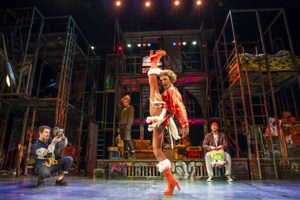
Rent is centred around a group of young struggling artists in New York’s East Village – they are fighting the property expansion and development which threatens to take over their performance space and remain true to their artforms and to themselves. I know how this sounds! And yes – over the years Rent’s edgy style (and way of incorporating social commentary into a musical) has been mercilessly parodied and skewered by the likes of Team America.
And yet! There are so many layers to unwrap and musical styles to bask in throughout this show…and try as I might even all these years later after seeing the first show in 1998, I couldn’t get through the first three songs without ruining my mascara and blubbing (I also snorted out loud…in front of some minor Welsh celebs in the audience. Oh well!)
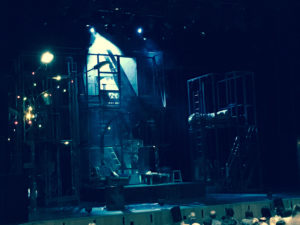
It’s sometimes a mistake to get so accustomed to an original cast recording that you can’t imagine anyone else singing those parts. All these years, I had no idea I was loving the voice of someone who would later become the voice of a Disney character (Idina Menzel, the original cast member for ‘Maureen’ went on to become the voice of Elsa, much to the annoyance of parents worldwide who had to listen to ‘Let it go’ 1,000 times a day).
I wasn’t sure how Lucie Jones (an X-Factor contestant – pah!) would handle the role of Maureen. And I was entirely wrong to pre-judge her due to my dislike of the X-Factor because not only did Lucie Jones absolutely SLAY the role of Maureen, she brought out even more of a kooky side to her (and single-handedly inspired me to lose three stone so I can look as amazing as she did in that body stocking! Wow).
Ryan O’Gorman’s sweet portrayal of Collins was beautiful – and his silky baritone vocals not only matched the calibre of the broadway version of Rent but perhaps even went one step beyond it.
The interaction between Leyton Williams (who previously had the title role of London’s Billy Elliot) as the lovely Angel and Collins was a joy to witness – and Layton brought a whole new talent to Angel’s ‘Today for you, tomorrow for me’ routine with astonishing leaps, spins and flips….and all in outrageous heels and a cloak coat.
You might think Jonathan Larson’s energy and optimism in the music and lyrics may come across as syrupy and hammy….but lord knows we need this more in 2017 than we did in 1996 when Rent opened.
For me Rent’s underlying sadness is that for all it’s popularity and influence, writer/composer Jonathan Larson’s early death (age 35) meant that he never got to see any of the success and joy that this musical has brought to people over the last 20 years.
Even all these years later, Larson ‘s story remains relevant and engaging for modern audiences. We are what we own. We’re knee-deep in a culture of mindless McJobs and as Mark and Roger sing: ‘We’re living in America…leave your conscience at the tone’. In the age of deportations and walls and blind gun laws (let along the way the tide is turning against LGBTQ communities), I really do question humanity sometimes.
I don’t know how many terms Donald Trump has or how many years of damage our current generation has ahead of them, but though it all I’ll still listen that old Rent CD of mine and remind myself that ‘We’re Okay’.
Bruce Guthrie’s production and Cardiff’s warm and inviting reception to Rent’s songs show me that there are still good people in the world. And I know this because all of them were mooing, crying, laughing and on their feet by my side at the end.
I’m definitely not leaving it another 19 years before I see this show again!
https://www.wmc.org.uk/Productions/2017-2018/DonaldGordonTheatre/Rent/?view=Standard
Type of show: Theatre
Title: Rent
Venue: Wales Millennium Centre (Cardiff)
Dates: 3-8 April
Book, Music and Lyrics: Jonathan Larson
Directed by: Bruce Guthtie
Director/choreographer: Chantelle Carey
Billy Cullum (Mark Cohen)
Ross Hunter (Roger Davis)
Ryan O’Gorman (Collins)
Layton Williams (Angel Schunard)
Phillippa Stefani (Mimi Marquez)
Lucie Jones (Maureen Johnson)
Shanay Holmes (Joanne Jefferson)
Running time: 2.5hrs (approx)
Produced by: Idili Theatricals Ltd / Theatr Clwyd
REVIEW: RUTH RENDELL- A JUDGEMENT IN STONE, NEW THEATRE BY JAMES BRIGGS

 (4 / 5)
(4 / 5)
On Tuesday 4th April Cardiff’s New Theatre become a hub for wannabe sleuths as it welcomed the classic Murder Mystery play A Judgement In Stone by the prolific writer Ruth Rendell. Ruth Rendell is very highly regarded among Murder Mystery fans all over the world and much like Agatha Christie she has continued to grow in popularity even after her passing.
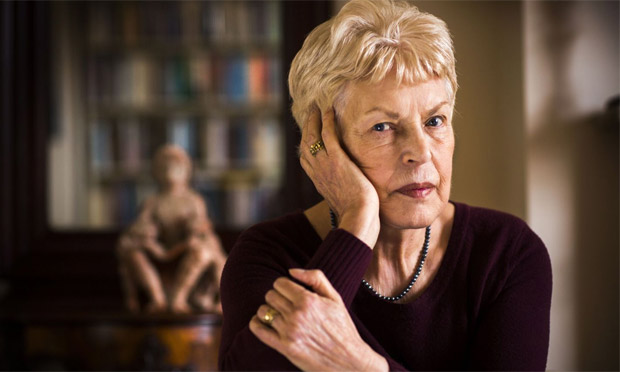
Ruth Rendell is very well known for writing very differently to other crime writers due to her focus being more on the psychological reasoning and effect with a murder opposed to looking in depth at the characters and their motives. This was shown largely in the play as the motive and act of the murder chilled me to the core!
Without giving away too much about the story the play opens with a crime scene set in the divine country mansion of the Coverdale family comprising of the murders of a father, mother, son and daughter. As the story unfolds before the audience on stage as does one of Rendell’s signature writing techniques with the inclusion of the ‘Class divide’. At the time of setting and writing the play the ‘class divide’ between the working class and upper class was at it’s biggest. With other shows made at the time such as Blood Brothers by Willy Russell also showing this divide. As the show progresses although the plot is a Murder Mystery one cannot help but pick up on the class references in the show.
Ruth Rendell creates exquisite characters who all have a different story to tell (and a different motive to kill). The first characters the audience encounter are the two central characters of the play Detective Superintendent Vetch (played by Andrew Lancel) and Sergeant Challoner (played by Ben Nealon). Both men are your typical ‘Coppers’. It is at this time the audience meet Eunice Parchman played by Sophie Ward who is the house keeper.

Following on from this the play very cleverly follows a Non-linear narrative and jumps from the present to the past. The audience meet the family and their individual personalities start to show. The family as shown in the picture below on the settee are Melinda Coverdale, George Coverdale, Jacqueline Coverdale and Giles Mont.

We also meet three other characters also shown in the picture Eva Baalham, Joan Smith and Roger Meadows who is played by BLUE star Antony Costa.
I simply must also mention the wonderful set designed for the show as it was amazing. It was very reminiscent to that of The Mouse Trap and had a wonderful sense of grandeur to it, really helping to set the scene for the audience. I highly recommend you watch this play especially if you are a Murder Mystery fan but WILL YOU SOLVE THE CASE?
A Judgement In Stone is currently playing at the New Theatre until Saturday 8th April so make sure you get your tickets here- http://www.newtheatrecardiff.co.uk/what’s-on/a-judgement-in-stone/
Review Junkyard: A New Musical at Theatr Clwyd by Gareth Williams
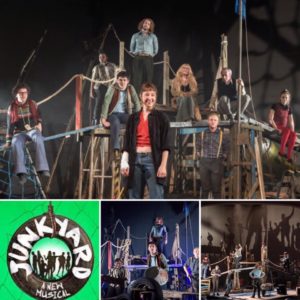
 (5 / 5)
(5 / 5)
Please don’t misunderstand me when I say that Junkyard: A New Musical is a load of rubbish. It is by no means of poor quality, lacking in characterisation, or short on story. I am actually making reference to the dynamic and inventive set. It is made (almost entirely) of waste material: planks of wood, old tyres, thick blue twine. It is a representation of the ‘Adventure Playground’, an idea pioneered in the 1960s and ‘70s. It provided a space for kids to call their own, where they could embrace risk and unleash their creativity.
Writer and director Jack Thorne has made this the setting for his latest production, having been inspired by his father, Mick. As one of the first play leaders at an adventure playground in Bristol, Thorne pays tribute to him in the character of Rick. Played by Calum Callaghan, Rick is a laid-back, rather soft man who, nevertheless, has a big heart. He wants to build a ‘Junk Playground’ in Bristol and hopes to get a group of teenagers involved in the process. However, this rowdy group of misfits prove more challenging than expected. What follows is a tragi-comic story as the lives of these young people become inextricably entwined in the building of this unconventional structure.
Leading this group of kids is Fiz, an outspoken and confident young lady played to perfection by Erin Doherty. Doherty is a delight to watch. Utterly captivating, she makes Fiz an instantly loveable personality. Full of humour and expressive action, Doherty allows just the right amount of vulnerability to seep through. Her performance is enhanced by an incredibly strong supporting cast. Each brings such life and vitality to their characters that one could easily mistake this for a social documentary. I recognise in the passionate anger of Ginger (Josef Davies), the stuttering speech of Talc (Enyi Okoronkwo), and the crude insults of Higgy (Jack Riddiford), traits not only from my own teenage years but personalities that I came across during my own time as a (not very good) youth worker.
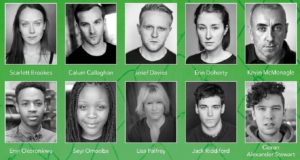
It is testament to the performances and quality of writing that one looks upon this as a marvellous work of social commentary. Yet what enhances this production to make it, in my opinion, a five-star play is the effective use of lighting and music. The opening sequence, repeated later in the play, is mesmerising. The use of torches and lighters immediately captures your attention and from then on, you are hooked. Stage-side throughout is a live band; always a winner in my book, but what makes this particular piece of musical theatre stand out is its intriguing blend of speech and lyrics. It uses a similar technique to the sung verbatim in London Road, yet here it is largely the internal thoughts and emotions of the characters that are sung as part of a more traditional narrative script.
There is plenty of humour in Junkyard. Some people may find the language a bit too crude or near-the-knuckle at times. There is also quite a lot of swearing. Again, some people might find this excessive. But I think it adds real charm to the whole thing. Its sense of realism cannot be questioned. It is a really immersive piece of theatre. It is challenging too. It makes you reconsider the very notion of what a playground is, how it is treated, and who it’s for.
Junkyards may be a load of rubbish, but this one is a work of art.
https://www.theatrclwyd.com/en/whats-on/junkyard/
Review Custody, Ovalhouse by Hannah Goslin
 (5 / 5)
(5 / 5)
It is hard to ignore a storyline such as Custody.
Based in Brixton, Custody, created by Urban Wolf and written by Tom Wainwright tells the fictional tale of a young black man’s death in police hands. As we have seen over the years of news reports with the similar headline but we only see the headline as voyeurs. This production takes the heart and soul behind these and gives them a face in a 2 year play by play of how the family of this fictional yet very real character process through this tragic event.
There’s moments of comedy for light relief, a little of black humour and satire of stereotypes but also such fantastic theatricality.
While there is music, the performers create soundscapes through sound and words. They build this into themselves physically and while it would seem a low physical production, you can tell it takes much hard work and perfection to get all of the timing and embodiment just right.
And the set is fantastic. Move able, dark and deep to bright, white and clinical. We never meet Brian he is spoken to as if he was there but we essentially feel his presence in the performers emotions. And these emotions are natural and relatable.
Attention to detail is key – the weight of Brian’s memory is represented by bags that each performer wears, very little are these let go until they let go of him.
Custody is everything you want in a production, it has heart, theatricality and sends a message.
http://www.ovalhouse.com/whatson/detail/custody-by-urban-wolf

